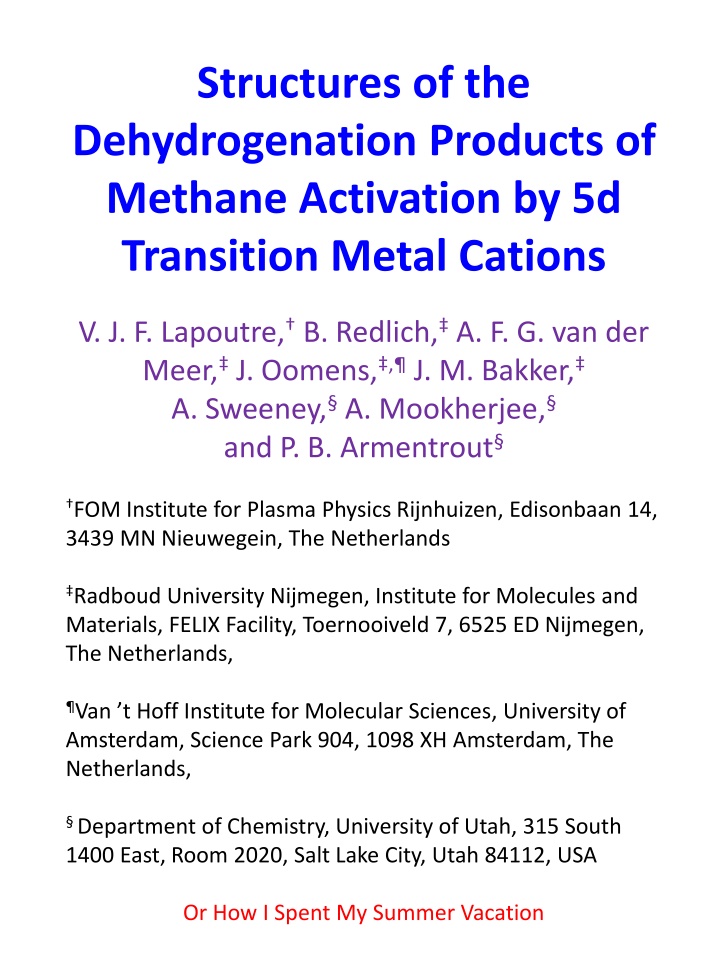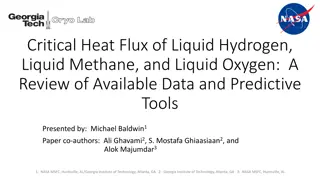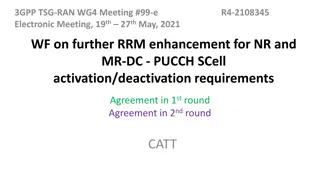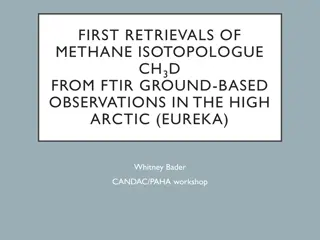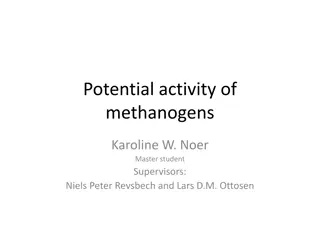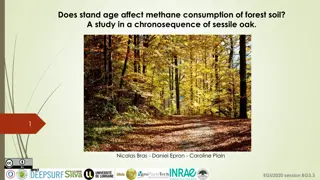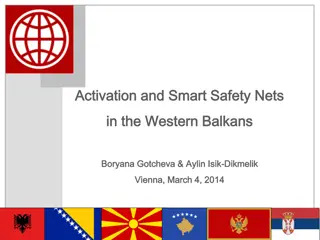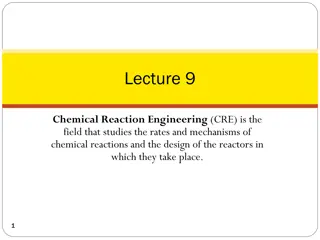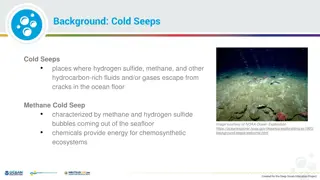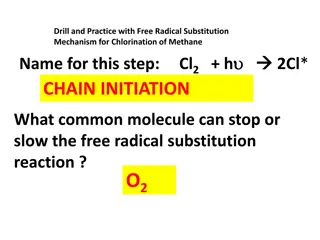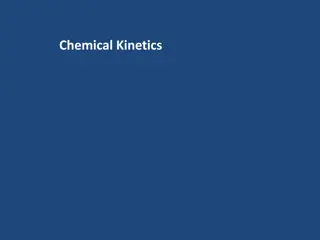Structures of Dehydrogenation Products: Methane Activation by 5d Transition Metal Cations
Methane dehydrogenation and conversion to other chemicals using third-row metal cations is explored through experimental examination of the structures formed, aided by high laser power provided by FELICE.
Download Presentation

Please find below an Image/Link to download the presentation.
The content on the website is provided AS IS for your information and personal use only. It may not be sold, licensed, or shared on other websites without obtaining consent from the author.If you encounter any issues during the download, it is possible that the publisher has removed the file from their server.
You are allowed to download the files provided on this website for personal or commercial use, subject to the condition that they are used lawfully. All files are the property of their respective owners.
The content on the website is provided AS IS for your information and personal use only. It may not be sold, licensed, or shared on other websites without obtaining consent from the author.
E N D
Presentation Transcript
Structures of the Dehydrogenation Products of Methane Activation by 5d Transition Metal Cations V. J. F. Lapoutre, B. Redlich, A. F. G. van der Meer, J. Oomens, , J. M. Bakker, A. Sweeney, A. Mookherjee, and P. B. Armentrout FOM Institute for Plasma Physics Rijnhuizen, Edisonbaan 14, 3439 MN Nieuwegein, The Netherlands Radboud University Nijmegen, Institute for Molecules and Materials, FELIX Facility, Toernooiveld 7, 6525 ED Nijmegen, The Netherlands, Van t Hoff Institute for Molecular Sciences, University of Amsterdam, Science Park 904, 1098 XH Amsterdam, The Netherlands, Department of Chemistry, University of Utah, 315 South 1400 East, Room 2020, Salt Lake City, Utah 84112, USA Or How I Spent My Summer Vacation
Motivation Methane is a key fossil fuel that is presently underutilized because it is difficult to transport. This problem could be solved by conversion of methane to other chemicals. As originally demonstrated by Irikura and Beauchamp (J. Am. Chem. Soc. 1989, 111, 75 85; 1991, 113, 2769 2770), several third-row metal cations readily activate methane by dehydrogenation. However, the structures of the [M,C,2H]+ products have yet to be experimentally examined, although theory suggests several competing structures: metal carbene distorted carbene hydrido metal (agostic interaction) carbynea In order to successfully study such four atom species, which therefore have a low density of states, high laser power is required for IR multiple photon dissociation (IRMPD). Such power is provided by the intracavity operation of FELICE. aFirst calculated for WCH2+by Simon, Lemaire, Boissel, Ma tre, J. Chem. Phys. 2001, 115, 2510 2518.
Free-Electron Laser for IntraCavity Experiments - FELICE End/Angle mirror www.rijnhuizen.nl/en/research/guthz/felice; Bakker et al. J. Chem Phys. 132, 074305 Higher fluences of IR radiation Expands spectral region to lower frequencies (2010)
Molecular Beam Experiment Bakker et al. J. Chem Phys. 132, 074305 (2010)
Experimental Details Samples of Ta, W, Ir, or Pt (rods) were ablated with a frequency doubled YAG laser (532 nm) to create gas phase ions and neutrals. Gas phase transition metals were carried by He and interacted with a pulsed flow of methane gas to form metal complexes. For all four metals, the [M,C,2H]+ species are formed in abundance. Ions were then irradiated in FELICE where they were dissociated with multiple photons over a range of about 400 3500 cm-1. Fragments and parent ions are pulse extracted ~10 s after interaction and mass analyzed by a reflectron time-of-flight mass spectrometry (ReTOF MS) and detected. Dissociation of complexes at various wavelengths corresponds to the resonant absorption of photons at that specific vibrational mode. The [M,C,2H]+ species of M+ = Ta+, W+, and Pt+ were all observed to dissociate by H atom loss, whereas for M+ = Ir+, loss of H2 predominates. These observations are consistent with the known thermochemistry in all cases.
Density Functional Theory Calculations of [M,C,2H]+ structures and vibrational frequencies were conducted at the B3LYP level using the def2-TZVPPD basis set. The def2-TZVPPD basis set is a balanced triple-zeta basis set with a small-core effective core potential for the heavier elements. Harmonic frequencies are calculated and scaled by a global scaling factor of 0.939 to compensate for anharmonicity and experimental redshifting caused by the multiple photon nature of IRMPD. The global scaling factor is determined by fitting the calculated spectrum of the lowest energy [Pt,C,2H]+ structure to the experimental spectrum. All DFT calculations were performed using the Gaussian 03 suite of programs. To verify that this level of theory is adequate, several additional calculations were carried out on the [Pt,C,2H]+ system by Prof. C. van W llen. An all-electron quasi- relativistic zero-order regular approximation (ZORA) calculation was done along with scalar-relativistic calculations, and two-component calculations that include spin-orbit coupling. None of these alternative approaches led to appreciable differences in the calculated spectra.
0.60 PtCH2+ 0.40 Intensity 0.20 0.00 -34 kJ/mol PtCH2+(2A1) 60 Intensity 40 20 0 33 kJ/mol PtCH2+(2A2) 60 Intensity 40 20 400 0 65 kJ/mol HPtCH+(2A'') 300 Intensity 200 100 0 500 1000 1500 2000 2500 3000 3500 Frequency (cm-1) IRMPD spectrum for [Pt,C,2H]+ (top) and calculated spectra for the species shown. Energies relative to Pt+ + CH4 are indicated.
0.50 TaCH2+ 0.40 Intensity 0.30 0.20 0.10 0.00 +(3A'') 250 -4 kJ/mol TaCH2 200 Intensity 150 100 50 200 0 +(1A') 32 kJ/mol TaCH2 150 Intensity 100 50 400 0 HTaCH+(1A') 54 kJ/mol 300 Intensity 200 100 0 500 1000 1500 2000 2500 3000 3500 Frequency (cm-1) IRMPD spectrum for [Ta,C,2H]+ (top) and calculated spectra for the species shown. Energies relative to Ta+ + CH4 are indicated.
0.5 WCH2+ 0.4 Intensity 0.3 0.2 0.1 0.0 200 Frequency (cm-1) -13 kJ/mol WCH2+(4A'') 150 Intensity 100 50 0 HWCH+(2A') 4 kJ/mol 150 Intensity 100 50 0 200 WCH2+(4B2) 37 kJ/mol 150 Intensity 100 50 0 500 1000 1500 2000 2500 3000 3500 Frequency (cm-1) IRMPD spectrum for [W,C,2H]+ (top) and calculated spectra for the species shown. Energies relative to W+ + CH4 are indicated.
0.16 IrCH2+ 0.12 Intensity 0.08 x5 0.04 0.00 HIrCH+(1A') -80 kJ/mol 200 Intensity 150 100 50 0 100 IrCH2+(3A2) -56 kJ/mol 80 Intensity 60 40 20 0 HIrCH+(3A') 17 kJ/mol 120 Intensity 80 40 0 500 1000 1500 2000 2500 3000 3500 Frequency (cm-1) IRMPD spectrum for [Ir,C,2H]+ (top) and calculated spectra for the species shown. Energies relative to Ir+ + CH4 are indicated.
Conclusions PtCH2+is almost certainly the metal carbene, which can be formed exothermically in the reaction of Pt+ with CH4. The peak at 1980 cm-1 us attributed to an overtone. TaCH2+ and WCH2+are almost certainly the agostically distorted metal carbenes, which can both be formed exothermically in the reaction of Ta+ and W+ with CH4. Unexpectedly, IrCH2+ shows evidence of both a hydrido carbyne and a carbene structure, both of which can be formed exothermically in the reaction of Ir+ with CH4.
Potential energy surface for formation of HIrCH+ and IrCH2+ 2 singlet triplet quintet 1 TS1 HIrCH+ + H2 Ir+(1G) TS5 Ir+(3F) 0 Energy (eV) IrCH2+ + H2 TS6 Ir+(5F) + CH4 TS5 TS4 TS1 HIrCH+ + H2 TS3 -1 H3IrCH+ TS6 Ir+(CH4) (H2)HIrCH+ -2 H-Ir+-CH3 HIrHCH2+ -3 Reaction Coordinate HIrCH+ should be formed easily from Ir+ + CH4 but requires coupling of the quintet and singlet surfaces. Previous theoretical studies of the reaction of Ir+ + CH4 did not consider the formation of the hydrido carbyne, but showed carbene formation was facile, requiring quintet/triplet coupling. Perry, Ohanessian, Goddard, Organomet. 1994, 13, 1870. Musaev, Morokuma, Isr. J. Chem. 1993, 33, 307. Li, Zhang, Armentrout, Int. J. Mass Spectrom. 2006, 255-256, 279.
Acknowledgements This work is financially supported by the NSF (CHE-1049580 and PIRE-0730072), the research program of the Stichting voor Fundamenteel Onderzoek der Materie (FOM) , and the Nederlandse Organisatie voor Wetenschappelijk Onderzoek (NOW). The authors are also thankful for the helpful staff at the FOM institute, especially those involved in the operation and maintenance of the FELICE beam line.
